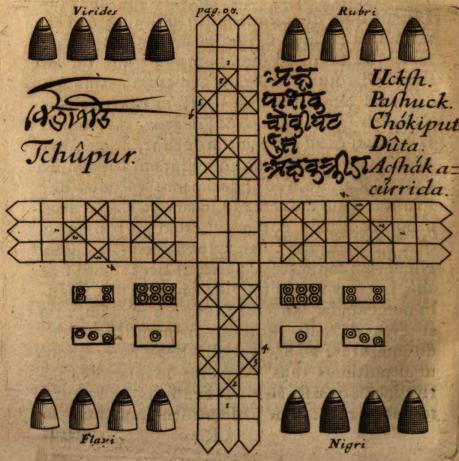Sep 10-12, 2025
Games Across Asia: The Primary Sources of Play
- 09:00 to 17:00
- Workshop
- Max Planck Research Group (ASTRA)

The game of Tchûpur (Hi. caupaṛ) as it appears in De Ludis Orientalibus (1694) by Thomas Hyde. Scanned by Münchener DigitalisierungsZentrum.
The history of games in Asia is really a history of games across Asia. Whether you play Shatranj in Iran, Chaturanga in India, Xiangqi in China, or Shogi in Japan, you are part of an Asian-wide community of players engaging with the manifold forms of chess. And the same is true of numerous other games which have traveled and transformed across Asia for millennia.
The interconnected nature of Asian games is not reflected in the community of scholars who tend to study them only within the confines of their own region of expertise. The Games Across Asia workshop challenges the regional isolation of Asian game scholarship by providing a trans-regional platform for knowledge exchange and collaborative research.
The earliest attempt at a trans-regional study of Asian games is De Ludis Orientalibus (On the Games of the Orient) written by Thomas Hyde in the late 17th century. Hyde was proficient in a variety of Asian languages, including Turkish, Persian, Chinese, and Malay, and had privileged access to native speakers in his role as Eastern Interpreter to the Court. Still, he never visited the homelands of his informants and often displayed an obvious lack of familiarity with the games he was describing.
It was only two centuries later that a similar effort was undertaken by the American ethnographer Stewart Culin. As director of the University of Pennsylvania Museum in the late 19th century, Culin gathered information from an extensive network of informants and conducted his own fieldwork among Chinese immigrants in the US. His contributions helped shape the modern field of historical game studies, but like Hyde before him he never visited Asia himself.
It would take yet another century before the studies of Hyde and Culin were followed up by the exhibition catalogue Asian Games: The Art of Contest edited by Colin Mackenzie and Irving Finkel in 2004. The catalogue includes articles by scholars specializing in different parts of Asia and provides high-quality photographs of rare game objects from private and public collections. It constitutes an important first step in fostering a deeper conversation between scholars of Asian games, but little has been done since to take it further.
Building on the current Ludic Languages of Asia lecture series, the Games Across Asia workshop brings together scholars with different regional specializations and invites them to share their work on the primary textual sources of Asian games. Recognizing that material, visual, and even ethnographical studies tend to circulate more easily and more widely than textual studies, the workshop has chosen the extensive yet little explored game literature of Asia as its main focus.
Participants are asked to introduce primary sources in their own language of expertise and read key passages from them together with the other participants despite the lack of shared linguistic competencies. The aim is to familiarize each other with the context, structure, content, and terminology of a variety of ludic texts from across Asia. Tangible outcomes include bibliographies of primary sources, comparative lists of ludic terminologies, and an anthology of translations from the ludic texts presented.
Contact and Registration
The workshop will take place at the Max Planck Institute for the History of Science on September 10–12, 2025. Attendance is by invitation only, but anyone interested in the subject is encouraged to reach out to Jacob Schmidt-Madsen for future collaboration.
